| The Top Ten Greatest Plant Monsters |
| #10 - The Orcwort |
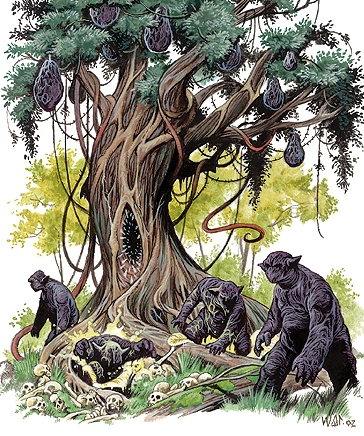
The most obscure thing on our list, the Orcwort is a seldom-used monster from the Dungeons
and Dragons roleplaying universe, but well remembered by those who have encountered it in
the land of organized make-believe. After all, what could be more memorable than a walking,
flesh-eating tree that grows its own faceless, humanoid minions? The creepy, eerily
orc-shaped podlings both defend their parent tree from attackers and bring it fresh food, even
raiding nearby villages for living victims. It's horrific and ridiculous. It's horriculous.
and Dragons roleplaying universe, but well remembered by those who have encountered it in
the land of organized make-believe. After all, what could be more memorable than a walking,
flesh-eating tree that grows its own faceless, humanoid minions? The creepy, eerily
orc-shaped podlings both defend their parent tree from attackers and bring it fresh food, even
raiding nearby villages for living victims. It's horrific and ridiculous. It's horriculous.
| #9 - Otesánek |
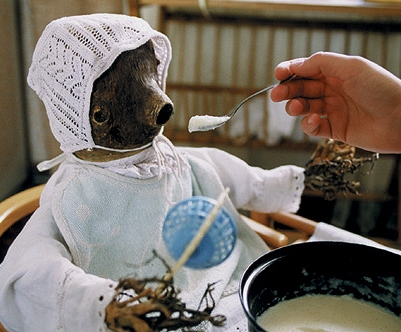
Otesánek or "Greedy Guts" is a Czechoslovakian children's fable in which a woodsman digs up
a child-shaped tree stump and brings it home to his barren wife. Fed and nurtured like a real
child, the chunk of wood becomes a living being with an insatiable hunger, devouring its
parents, outgrowing the entire house and wandering the countryside, wolfing down everyone
and everything it comes across.
In 2000, legendary stop-motion artist Jan Svankmajer modernized the fable with Little Otik, a
surreal horror-comedy retelling the story in an apartment complex. The entire cast is weird and
warped, but the flesh-eating stump unsurprisingly steals the show, with an amazingly disturbing
design and even more disturbing infantile wails. Particularly fascinating is how the monster's
single facial orifice alternately contains a human-like eyeball or monstrous teeth!
a child-shaped tree stump and brings it home to his barren wife. Fed and nurtured like a real
child, the chunk of wood becomes a living being with an insatiable hunger, devouring its
parents, outgrowing the entire house and wandering the countryside, wolfing down everyone
and everything it comes across.
In 2000, legendary stop-motion artist Jan Svankmajer modernized the fable with Little Otik, a
surreal horror-comedy retelling the story in an apartment complex. The entire cast is weird and
warped, but the flesh-eating stump unsurprisingly steals the show, with an amazingly disturbing
design and even more disturbing infantile wails. Particularly fascinating is how the monster's
single facial orifice alternately contains a human-like eyeball or monstrous teeth!
| #8 - Grass-type Pokemon |


















Maybe it's cheating to split a single spot amongst several dozen creatures, but it's tough to
pick a favorite from the plant based Pocket Monsters, and once you get into their twisted
reproductive patterns, all Pokemon are technically just one species anyway. Those with a
vegetable slant are categorized as "grass" type Pokemon, and a shining example of the
franchise's sense for the iconic. In the world of Pokemon, the abominable snowman or yeti is
actually a form of walking evergreen tree, scarecrow-shaped Cacti come alive at night to prey
upon the weak like a pack of hyenas, majestic banana-tree-dinosaurs soar the skies and
psychic coconut trees debate amongst their multiple heads.
Just another day in an ecosystem that evolved around eye-lasers.
pick a favorite from the plant based Pocket Monsters, and once you get into their twisted
reproductive patterns, all Pokemon are technically just one species anyway. Those with a
vegetable slant are categorized as "grass" type Pokemon, and a shining example of the
franchise's sense for the iconic. In the world of Pokemon, the abominable snowman or yeti is
actually a form of walking evergreen tree, scarecrow-shaped Cacti come alive at night to prey
upon the weak like a pack of hyenas, majestic banana-tree-dinosaurs soar the skies and
psychic coconut trees debate amongst their multiple heads.
Just another day in an ecosystem that evolved around eye-lasers.
| #7 - Piranha Plants |
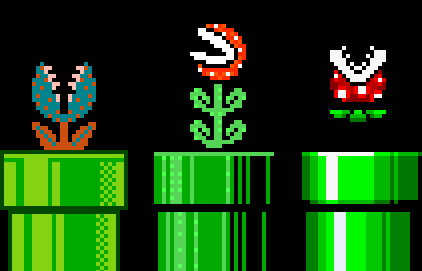
For some of us, Piranha Plants were the very first carnivorous flora we ever encountered in
our entertainment, unleashed upon the world by Super Mario Brothers on the Nintendo
Entertainment System in 1985. In their earliest appearance, the beasts simply emerged from
pipes to take a big bite out of Mario or Luigi, and while they've stuck with the pipe shtick to this
day, they've also taken literally dozens of new forms over the years and even experienced
their first role as a playable character in Mario Kart: Double Dash. You are not a gamer until
you've been a meat-eating plant in a go-kart.
our entertainment, unleashed upon the world by Super Mario Brothers on the Nintendo
Entertainment System in 1985. In their earliest appearance, the beasts simply emerged from
pipes to take a big bite out of Mario or Luigi, and while they've stuck with the pipe shtick to this
day, they've also taken literally dozens of new forms over the years and even experienced
their first role as a playable character in Mario Kart: Double Dash. You are not a gamer until
you've been a meat-eating plant in a go-kart.
| #6 - Biollante |
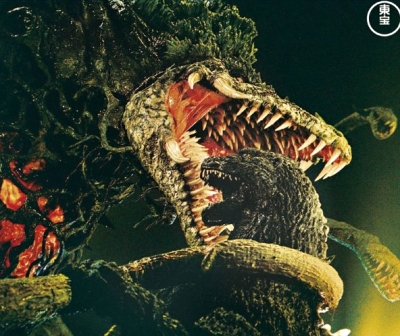
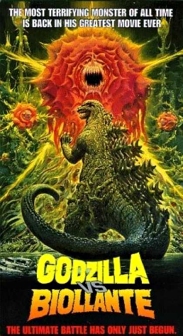
Objectively the biggest and baddest on the list, Biollante was the antagonist of the 1989
Godzilla vs. Biollante, and one of Toho studio's largest, most elaborate creations. Far from
your garden-variety vegetable kaiju, Biollante is the result of a geneticist's attempt to create an
everlasting rose with the DNA of his dead daughter and a certain big-ass lizard. Now those are
coping skills!
What happens when you cross atomic dinosaur genes with absolutely anything should come
as no surprise to anybody living in the toho universe, but the scientist is if anything pleased
when his creation grows out of control and threatens the fall of mankind. Fortunately, Godzilla
steps in to fry the rampaging flower with his nuclear breath. Unfortunately, the plant only grows
even bigger, more violent, and more reptilian in the process. In either form, you would be
hard-pressed to find a more epic cinematic vegetable, as our friend Bob elegantly expresses.
Godzilla vs. Biollante, and one of Toho studio's largest, most elaborate creations. Far from
your garden-variety vegetable kaiju, Biollante is the result of a geneticist's attempt to create an
everlasting rose with the DNA of his dead daughter and a certain big-ass lizard. Now those are
coping skills!
What happens when you cross atomic dinosaur genes with absolutely anything should come
as no surprise to anybody living in the toho universe, but the scientist is if anything pleased
when his creation grows out of control and threatens the fall of mankind. Fortunately, Godzilla
steps in to fry the rampaging flower with his nuclear breath. Unfortunately, the plant only grows
even bigger, more violent, and more reptilian in the process. In either form, you would be
hard-pressed to find a more epic cinematic vegetable, as our friend Bob elegantly expresses.
| #5 - Swamp Thing |
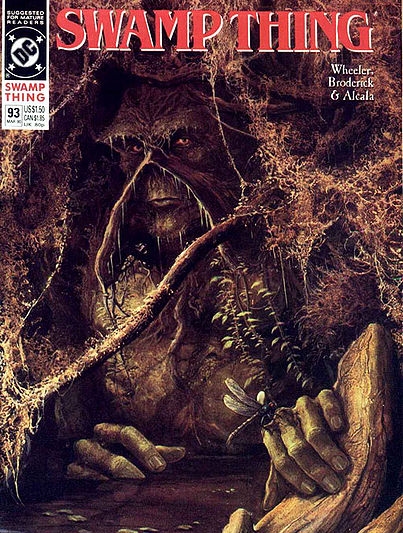
A complex character in the DC comics multiverse, Swamp Thing was originally written as a
scientist horribly mutated into a fusion of man and plant. Later, the character would evolve into
a more supernatural entity, an elemental force of nature. Able to communicate with, control,
and even manifest from any plant life in the world at any time, Swamp Thing is a virtually
unstoppable guardian of nature who has taken on mad scientists, mutants, aliens and even
the entire forces of hell.
Despite some of the comic's dark and horrifying themes, Swamp Thing "enjoyed" a brief stint
as a Saturday Morning cartoon hero, complete with a toy line that he'd probably like to forget,
with figures like Bayou Jack and Snake-Arm Swamp Thing. It was a villain from this line,
however, which sorta kinda half-inspired the name of my website.
scientist horribly mutated into a fusion of man and plant. Later, the character would evolve into
a more supernatural entity, an elemental force of nature. Able to communicate with, control,
and even manifest from any plant life in the world at any time, Swamp Thing is a virtually
unstoppable guardian of nature who has taken on mad scientists, mutants, aliens and even
the entire forces of hell.
Despite some of the comic's dark and horrifying themes, Swamp Thing "enjoyed" a brief stint
as a Saturday Morning cartoon hero, complete with a toy line that he'd probably like to forget,
with figures like Bayou Jack and Snake-Arm Swamp Thing. It was a villain from this line,
however, which sorta kinda half-inspired the name of my website.
| #4 - Man-Thing |
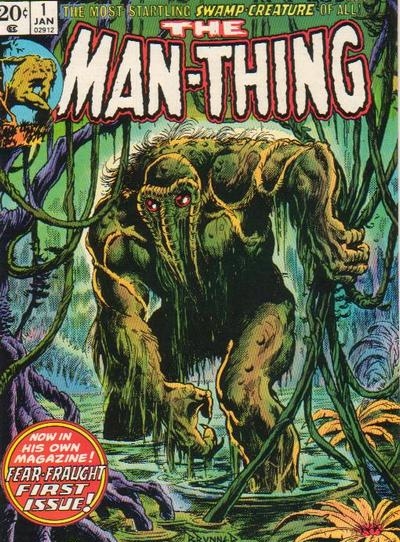
DC's Swamp Thing and Marvel's Man-Thing bear some striking similarities and debuted the
same year, but the circumstances behind this are a quagmire even they would find too sticky.
Suffice to say, Man-Thing came first, and while not quite as popular or prevalent as Swampy,
I'm inclined to prefer him. Largely conceived by comic legend Stan Lee - father of Spider-man
and the X-men - Man-Thing is neither hero nor villain, but a primal monster with only faint
memory of its former life as biochemist Theodore Sallis. While studying the same "super
soldier serum" that created one Captain America, Sallis was attacked by a terrorist group and
injects himself with his remaining sample, only to crash his car in the everglades where the
serum interacted with mysterious, cosmic forces to create an entirely new creature. In the
presence of negative emotions, this shambling mass of plant matter secretes a deadly acid
from its entire body, a power particularly triggered by fear, resulting in many unfortunate
mishaps for good and evil characters alike.
same year, but the circumstances behind this are a quagmire even they would find too sticky.
Suffice to say, Man-Thing came first, and while not quite as popular or prevalent as Swampy,
I'm inclined to prefer him. Largely conceived by comic legend Stan Lee - father of Spider-man
and the X-men - Man-Thing is neither hero nor villain, but a primal monster with only faint
memory of its former life as biochemist Theodore Sallis. While studying the same "super
soldier serum" that created one Captain America, Sallis was attacked by a terrorist group and
injects himself with his remaining sample, only to crash his car in the everglades where the
serum interacted with mysterious, cosmic forces to create an entirely new creature. In the
presence of negative emotions, this shambling mass of plant matter secretes a deadly acid
from its entire body, a power particularly triggered by fear, resulting in many unfortunate
mishaps for good and evil characters alike.
| #3 - The Body Snatchers |
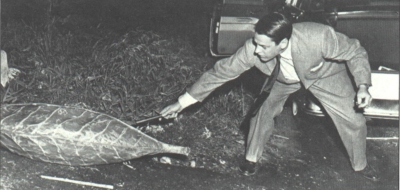
Easily a contender for one of the most disturbing and insidious alien invasions ever conceived,
the Body Snatchers first appear in a 1955 novel of the same name, and have had multiple film
adaptations. Falling to Earth as tiny spores, the organisms develop massive pods in the vicinity
of sleeping human beings, creating outwardly perfect duplicates or "pod people" literally
overnight, while the real humans crumble to dust. The clones have no emotion, cannot
reproduce, and live only a short time before sending a new wave of spores into space,
destroying one civilization after another.
In the original novel, humanity is triumphant in repelling the beings, but the more famous film
adaptations have preferred darker, more open endings. 1956's "Invasion of the Body
Snatchers" ends with only one man aware of the alien menace, thrown in prison as a lunatic
even as the alien pods begin to spread. In the 1978 remake, the pod people memorably emit a
horrific siren-like scream when they discover a real human in their midst.
the Body Snatchers first appear in a 1955 novel of the same name, and have had multiple film
adaptations. Falling to Earth as tiny spores, the organisms develop massive pods in the vicinity
of sleeping human beings, creating outwardly perfect duplicates or "pod people" literally
overnight, while the real humans crumble to dust. The clones have no emotion, cannot
reproduce, and live only a short time before sending a new wave of spores into space,
destroying one civilization after another.
In the original novel, humanity is triumphant in repelling the beings, but the more famous film
adaptations have preferred darker, more open endings. 1956's "Invasion of the Body
Snatchers" ends with only one man aware of the alien menace, thrown in prison as a lunatic
even as the alien pods begin to spread. In the 1978 remake, the pod people memorably emit a
horrific siren-like scream when they discover a real human in their midst.

| #2 - The Triffids |
In John Wyndham's 1951 novel "The Day of the Triffids," Earth is seemingly invaded by a new
species of plant (implied to be a Soviet experiment) capable of sluggishly shuffling about on
three legs and inflicting a fatal sting with a long, snapping tentacle. If you think this sounds like
a fairly avoidable threat, well, you're right. Years pass, and while the Triffids establish
themselves throughout the world, they are little more than a nuisance. When they turn out to
be a source of the finest quality cooking oil, they even become just another staple crop - albeit
a little more dangerous to handle than a cornfield.
species of plant (implied to be a Soviet experiment) capable of sluggishly shuffling about on
three legs and inflicting a fatal sting with a long, snapping tentacle. If you think this sounds like
a fairly avoidable threat, well, you're right. Years pass, and while the Triffids establish
themselves throughout the world, they are little more than a nuisance. When they turn out to
be a source of the finest quality cooking oil, they even become just another staple crop - albeit
a little more dangerous to handle than a cornfield.
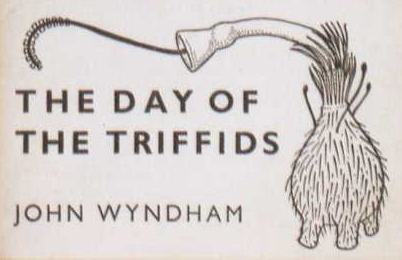
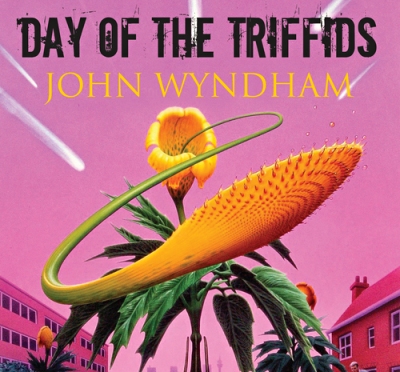
It is through entirely unrelated circumstances that the tables are finally turned. When a freak
meteor shower lights up the night with a dazzling alien glow, all but a fraction of humanity catch
at least a glimpse of the amazing spectacle. By the following morning, every single person who
saw the light has been left permanently blind. This alone would be a fairly chilling tale of
civilization's collapse, but this is the version of Earth with the venomous walking trees
everywhere. Millions of the blind fall victim to the plants, who multiply out of control until the
visually abled minority are forced into isolation.
Pockets of survivors against endless hordes of slow but relentless monsters? I'm sure
something about this probably sounds familiar to you kids today.
meteor shower lights up the night with a dazzling alien glow, all but a fraction of humanity catch
at least a glimpse of the amazing spectacle. By the following morning, every single person who
saw the light has been left permanently blind. This alone would be a fairly chilling tale of
civilization's collapse, but this is the version of Earth with the venomous walking trees
everywhere. Millions of the blind fall victim to the plants, who multiply out of control until the
visually abled minority are forced into isolation.
Pockets of survivors against endless hordes of slow but relentless monsters? I'm sure
something about this probably sounds familiar to you kids today.
| #1 - Audrey II |
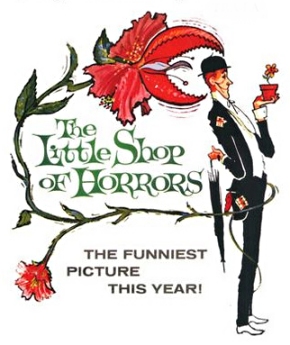
In 1960, director Roger Corman used leftover sets and leftover money to write and direct a
spontaneously conceived and thoroughly weird last-minute film in only two days; a dark
horror-comedy where a geeky botanist is conned into feeding a predatory plant. The hastily
cobbled-together Little Shop of Horrors was a surprise hit, and in 1982, the story was adapted
beyond all reason into a fantastic Broadway musical. In 1986, the musical in turn was adapted
into an even more epic and amazing film by puppeteer Frank Oz, regrettably robbed of its true
ending (more on that later) but nonetheless an incredible feat of movie magic. Today, the
Broadway version is still one of the most popular stage shows performed by schools and
theater groups across the nation.
spontaneously conceived and thoroughly weird last-minute film in only two days; a dark
horror-comedy where a geeky botanist is conned into feeding a predatory plant. The hastily
cobbled-together Little Shop of Horrors was a surprise hit, and in 1982, the story was adapted
beyond all reason into a fantastic Broadway musical. In 1986, the musical in turn was adapted
into an even more epic and amazing film by puppeteer Frank Oz, regrettably robbed of its true
ending (more on that later) but nonetheless an incredible feat of movie magic. Today, the
Broadway version is still one of the most popular stage shows performed by schools and
theater groups across the nation.
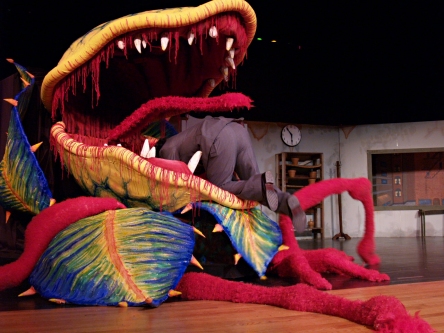
While hardly one of the earliest killer plants in popular culture, Audrey II is easily the most
influential. The tooth-lined pod atop a leafy stalk, surrounded by tentacular roots and vines,
has become the basic template for plant monsters everywhere, with Audrey knockoffs cropping
up throughout cartoons, video games, comics, toys and film. Greater than its iconic design,
however, is Audrey II's infectious personality.
influential. The tooth-lined pod atop a leafy stalk, surrounded by tentacular roots and vines,
has become the basic template for plant monsters everywhere, with Audrey knockoffs cropping
up throughout cartoons, video games, comics, toys and film. Greater than its iconic design,
however, is Audrey II's infectious personality.
| A performance by Drury High School of Massachusetts |
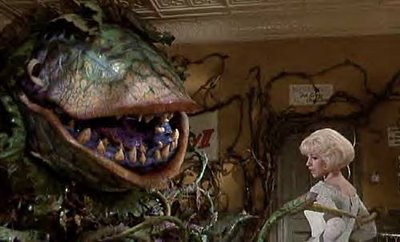
Far from a mindless flesh-eater, the predatory plant is a smooth-talking, manipulative bully who
strikes up a Faustian agreement with meek, gullible florist Seymour Krelbourn, promising the
geeky kid fame, fortune and romance in exchange for a little blood. First his own, then the
blood - and meat - of anyone who gets in his way. In the theatrical release of the Frank Oz film,
a "happier" ending, killing off the monster, was hastily cobbled together to appease test
audiences. In the original cut, like the stage musical, Seymour pays the ultimate price for his
deal with the green devil, and Audrey II goes on to terrorize the world as it grows and
multiplies. This also happens to be one of the most epic, expensive scenes ever deleted from
a film, unfortunately only ever released as a colorless rough.
strikes up a Faustian agreement with meek, gullible florist Seymour Krelbourn, promising the
geeky kid fame, fortune and romance in exchange for a little blood. First his own, then the
blood - and meat - of anyone who gets in his way. In the theatrical release of the Frank Oz film,
a "happier" ending, killing off the monster, was hastily cobbled together to appease test
audiences. In the original cut, like the stage musical, Seymour pays the ultimate price for his
deal with the green devil, and Audrey II goes on to terrorize the world as it grows and
multiplies. This also happens to be one of the most epic, expensive scenes ever deleted from
a film, unfortunately only ever released as a colorless rough.
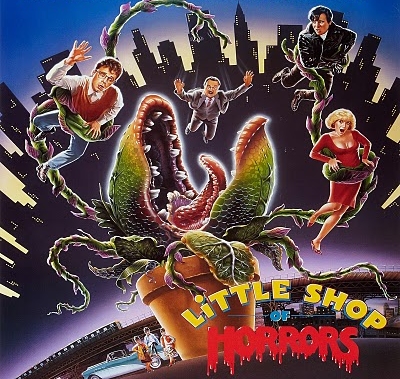
Audrey II is one of those few movie monsters to combine an entirely alien, inhuman
appearance with a lighthearted, charismatic personality, and it's a truly memorable
combination. If you've never seen the Mean Green Mother in action, it's probably time to
update your rental list. If you would rather spoil yourself now, enjoy the plant's two major
songs.
appearance with a lighthearted, charismatic personality, and it's a truly memorable
combination. If you've never seen the Mean Green Mother in action, it's probably time to
update your rental list. If you would rather spoil yourself now, enjoy the plant's two major
songs.
| ...BECAUSE I SAY SO. |